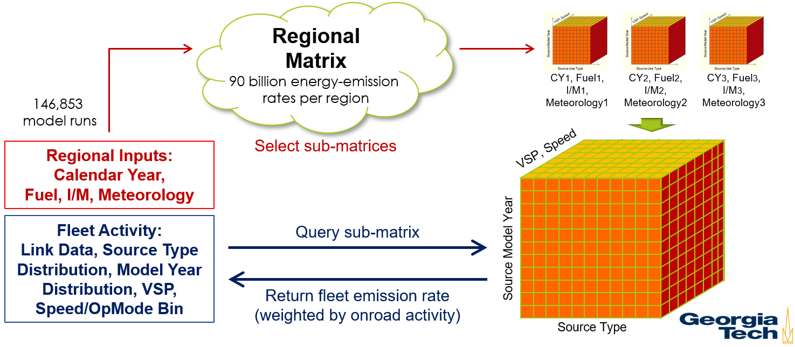The MOVES model was developed by the U.S. Environmental Protection Agency (U.S. EPA) to estimate emissions from on-road mobile sources and nonroad sources in the United States. Coupling high-resolution on-road vehicle activity data with appropriate MOVES emission rates further advances research efforts designed to assess the environmental impacts of transportation design and operation strategies. However, the complicated MOVES interface and slow performance makes it difficult to assess large, regional scale transportation networks and to undertake analyses of large-scale systems that are dynamic in nature. The MOVES-Matrix system develops a Large Matrix of MOVES outputs by running MOVES 146,853 times on the PACE high performance computing cluster to generate more than 90 billion emission rates to populate the matrix for a single area with one fuel regime and one inspection and maintenance program.

Conceptual Flow of MOVES-Matrix
A total of 117 such Large Matrices would be needed for the entire United States (i.e., unique combinations of fuel configurations and I/M programs), and a map of MOVES-Matrix coverage is shown below. If you are interested in one of the regions that has not been covered, please don’t hesitate to reach out to our team at randall.guensler@ce.gatech.edu and hlu305@gatech.edu, and we’ll be happy to prioritize running those regions for you.

MOVES-Matrix 2014b Coverage
The MOVES-Matrix system developed can be used to conduct the emissions modeling 200-times faster than using MOVES. The hypothetical case study shows that MOVES-Matrix is able to generate the exact same emission results as the MOVES model to ensure the validity for regulatory analysis. The resulting matrix allows users to link emission rates to big data projects and to evaluate changes in emissions for dynamic transportation systems in near-real-time. MOVES-Matrix currently provides the emissions and energy use rates for MOVES2014b, and the team is working on expanding MOVES-Matrix to the latest version of MOVES (MOVES3.0.4).
More information on the development can be found as follows.
